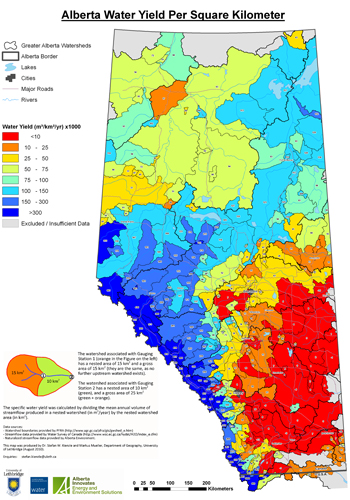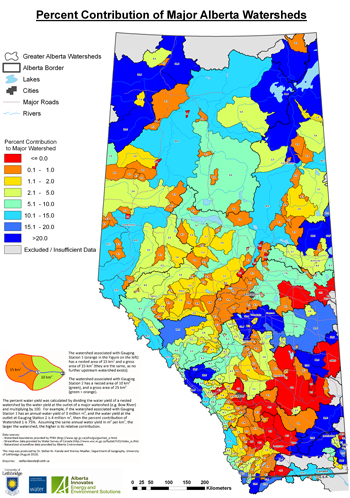Water Yield can be calculated by dividing the mean annual volume of streamflow that is produced in a nested watershed (expressed in cubic meters per year), by the area of the nested watershed (expressed in square kilometers).
| Water Yield = |
Mean annual volume of streamflow (produced in a nested watershed) |

The area of a nested watershed can be determined using the following approach:
The water yield can also be expressed in mm, as both precipitation and evaporation are typically expressed in mm. For example, a watershed with 1,000 mm annual precipitation, and an annual 40%, (i.e. 400 mm), water loss due to evaporation, would have a water yield of 600 mm per year.
A total of 287 watersheds in Alberta were analyzed for water yield. The water yields vary from negative values in 12 prairie watersheds, where more water enters the watershed than is flowing out (this is possible due to evaporation losses within the watershed), to values of over half a million m3 per km2 per year in 21 high altitude Rocky Mountain watersheds. The water yield in Alberta has a distinct spatial distribution, with three major areas.

|
|
Water Yield |
Water Yield |
Number of watersheds |
|
Average |
137,000 |
137 |
– |
|
Minimum |
-35,000 |
-35 |
– |
|
Maximum |
1,084,000 |
1,084 |
– |
|
Median |
64,000 |
64 |
– |
|
Low yield |
>25,000 |
>25 |
83 |
|
Medium yield |
25,000 – 300,000 |
25 – 300 |
164 |
|
High yield |
>300,000 |
>300 |
40 |

The second map shows what proportion of water yield within each of the major watersheds is produced where. This map is useful for water managers, as it provides insight into which are the most water producing watersheds.
The percent water yield is calculated by dividing the water yield of a nested watershed by the water yield at the outlet of a major watershed (eg: Bow River) and multiplying by 100. For example, if the watershed at Station 1 has an annual water yield of 3 million cubic meters, and the water yield at the outlet at Station 2 is 4 million cubic meters, then the percentage contribution of Watershed 1 is 75%. Assuming the same annual water yield (expressed in cubic meters per square kilometer), the larger the watershed, the higher its relative contribution.
The reader must bear in mind that the percentage (colour) is dependent on the size of the watershed. For example, where two neighbouring watersheds have the same water yield per km2, the larger watershed would have a higher proportion of water contribution. For example, during 1971 – 2000, almost 33% of all water flowing out of the Bow River at the confluence with the Oldman River is produced by two small sub-watersheds upstream of Banff, while another approximately 45% is produced in the other Rocky Mountain and adjacent foothill sub-watersheds. The entire lower half of the Bow River watersheds produces only, on average, 3% of the streamflow.
Share this Post:
We provide Canadian educational resources on water practices to promote conservation and sustainability. Our team crafts current and relevant content, while encouraging feedback and engagement.
The Canada WaterPortal is a registered charity, #807121876RR0001
We recognize and respect the sovereignty of the Indigenous Peoples and communities on whose land our work takes place.
© 2025 All Rights Reserved.